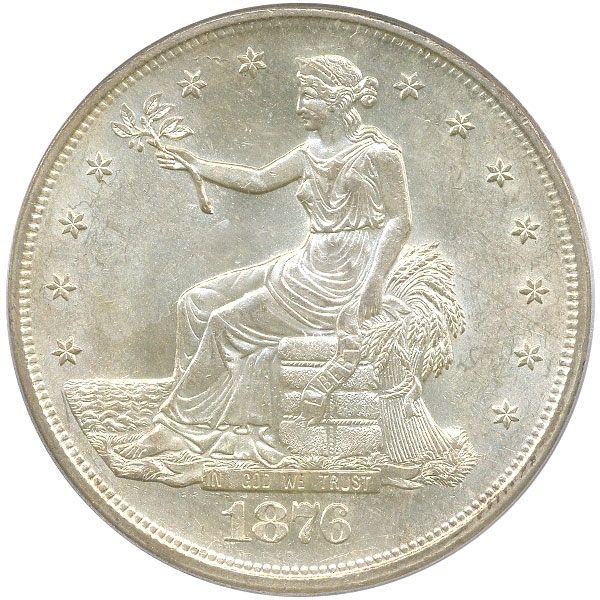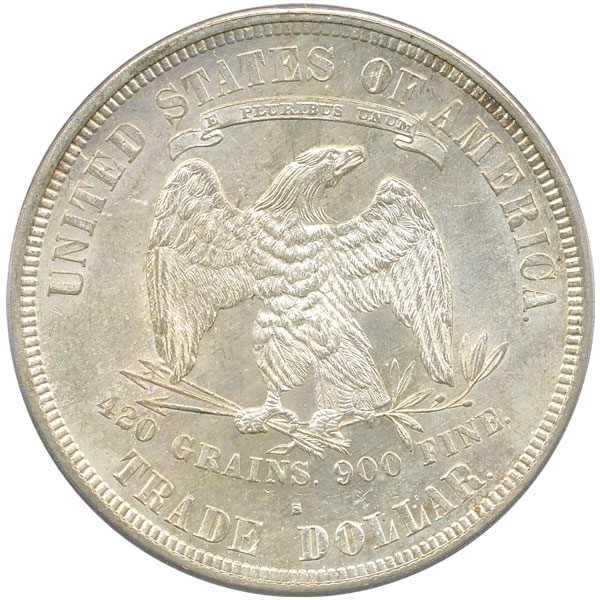1876-S T$1 MS63 认证号16339377, PCGS号7043
拥有者评论
CAC
专家评论
Q. David Bowers
The following narrative, with minor editing, is from my "Silver Dollars & Trade Dollars of the United States: A Complete Encyclopedia" (Wolfeboro, NH: Bowers and Merena Galleries, Inc., 1993):Coinage Context
High volume production: The year 1876 at the San Francisco Mint saw high volume production of trade dollars primarily from Nevada silver. Production was strong each month, and by the end of December some 5,227,000 coins had been ejected from the presses, a new record for the denomination. Many of these were made for the Nevada Bank of San Francisco (see testimony by Louis McLane, quoted under Additional Information, 1877).
Most coins were shipped to the Orient, although some were circulated domestically, particularly before the demonetization act of July 22, 1876 took effect.
Numismatic Information
Varieties: The 1876-S is known in three combinations: I/I, I/II, and II/II. A sample of 43 1876-S trade dollars studied by Mark Borckardt in 1992 contained 27 (62%) I/I, eight (19%) I/II, and eight (19%) II/II; although the data base is small, this seems to provide an indication of relative availability.
Circulated grades: Among issues of trade dollars, in grades from VF-20 to AU-58 the 1876-S is one of the most plentiful on the market today. I estimate that 25,000 or more exist worldwide. Among unchopmarked coins, Type II/II seems to be the scarcest.
Among chopmarked coins, Types I/I and II/II are said to be common; I/II is said to be rare. (These have not been studied by the author.)
Mint State grades: In MS-65 grade the 1876-S is rare, and probably no more than 20 to 40 or so exist. At the MS-64 level the estimated population is 100 to 200 or more, increasing to 175 to 300 or more at the MS-63 range. Most Mint State 1876-S trade dollars are in the MS-60 to 62 range, as reflected by the estimated population of 900 to 1,800 or more coins.
A common issue: Although MS-64 and finer coins are fairly scarce, in MS-60 through MS-63 grades this is the third most common circulation strike trade dollar. In circulated grades the 1876-S is believed to be the fifth most common trade dollar, exceeded in availability only by 1877-S (most common), 1878-S, 1875-S, and 1877. Chopmarked coins are common.
Doubled obverse die: A rare variety of 1876-S II/II shows extensive doubling. The branch hand, left foot, and parts of LIBERTY are doubled, among other features. Described below.
Varieties:
OBVERSE TYPE I: RIBBON ENDS POINT LEFT, 1873-1876
REVERSE TYPE I: BERRY BELOW CLAW, 1873-1876
Circulation strikes:
1. Micro s: Breen-5801. Still very rare.
2.Medium S: Mintmark .9 mm high. Not in Walter H. Breen's Encyclopedia. Extremely rare. Discovered by Jack Beymer. The only ones seen to date have no period after FINE; this is from hub damage and probably occurs on some other 1876 Type I reverses of various mints.
3. Large S: Breen-5800. Mintmark 1.17 mm high. Common. The most plentiful 1876-S. Often chop marked. Pieces with raised parallel die lines slanting up to right behind head are counterfeits.
OBVERSE TYPE I: RIBBON ENDS POINT LEFT, 1873-1876
REVERSE TYPE II: NO BERRY BELOW CLAW, 1875-1885
Circulation strikes:
1. Micro s: Breen-5802. Mintmark .75 mm high.
Considerably scarcer than preceding. Often chopmarked.
2. Minute s: Mintmark .84 mm high.
OBVERSE TYPE II, RIBBON ENDS POINT DOWN, 1876-1885
REVERSE TYPE II: NO BERRY BELOW CLAW, 1875-1885
1. Micro s: Breen-5803. Scarce. Some have the anomalous reverse. Type IIa, with large period after GRAINS (much larger than the comma on the normal II); rightmost leaf tip is pointed. The Santovenia Collection includes an MS-64 or finer coin.
2. Repunched 6: One variety of Breen-5803 has part of the base of what appears to be an extra 6 within upper part of loop of the 6; known to Marvin Jacobson by 1975 (see Willem correspondence quoted earlier), also identified by Jack Beymer. Some have called this an overdate, 1876/5, which it is not. It has also been suggested that this may be 1876/4, which would be impossible, as the obverse is Type II not used in 1874. This may be the most common variety of the 1876-S II/II issue.
3. Large S: Unconfirmed. Walter H. Breen states that this may exist.
4. Doubled obverse die: Fivaz & Stanton $1.00-013, commentary as follows: "Doubling is evident on Liberty's hand, olive branch, left foot. Possibly first reported around 1973." Further, Bill Fivaz reports the following concerning this issue: "This die exhibits nice doubling on Miss Liberty's chin, outstretched right hand, left foot, and some of the drapery. It has been a very difficult variety to find in any grade, and only two or three have been reported." Published by Ross Haddix, Coin World April 19, 1989, Coin World December 27, 1989. Very rare. Leroy C. Van Allen sold a specimen to the author in June 1992, noting that he knew of just three extant coins.
Unclassified
Additional variety, as yet unattributed to obverse and reverse types:
Doubled reverse die: Described in Coin World November 29, 1987. This variety has not been seen by me or by Walter H. Breen; only halftone newspaper pictures have been observed.
Dies prepared: Obverse: Unknown; Reverse: Unknown:
Circulation strike mintage: 5,227,000. Delivery figures by month: January: 342,000; February: 410,000; March: 706,000; April: 385,000; May: 318,000; June: 123,000; July: 127,000; August: 473,000; September: 450,000; October: 465,000; November: 545,000; December: 883,000.
Characteristics of striking: Usually well struck.
Some have evidence of light striking at the top of the obverse and at the eagle's sinister leg on the reverse. Among large mintage issues such as this there are many variations in striking quality.
Known hoards of Mint State coins: None
Rarity with original Chinese chopmark(s): Types II I and II/II are both common; I/II is rare.
Commentary
A common issue in all but the highest grades. More research needs to be done with minor die varieties.
Additional Information
A Glut of Trade Dollars
The American Journal of Numismatics, April 1876, reprinted the following newspaper commentary from the San Francisco Chronicle:
"The new trade dollar is fast becoming a drug in the market. Our banks and money-broker offices are becoming glutted with them. Their greater intrinsic value as well as their novelty threatened for awhile to crowd the familiar half dollar and the handy quarter out of sight.
"Chinamen remitting their hard-earned savings to their far-distant land would have nothing but trade dollars. (A reference to Chinese who had come to the United States to be laborers on railroads and other projects, and who sent part of their wages back home.) Oriental commerce was, and still is to a large extent, conducted on the solid basis of this bright, new and ringing silver representation of value.
"But the Orient, like San Francisco, is beginning to find that it is possible to be surfeited with even so much coveted a treasure as the trade dollar. The result is that reaction has set in against that coin in this market, and it no longer enjoys a preference over other silver. On the contrary, although a trade dollar is intrinsically worth eight cents more than two half dollars, the two halves will sell in the street from a half to three-quarters of a cent more than the dollar. The reason for this is primarily because of the super abundance of the latter. But there is another reason which is not generally understood. Halves and quarters of the United States are a legal tender for all payments up to a certain amount; the trade dollar is not a legal tender at all for any amount." It is merely a stamped ingot, having a certain value, like an ounce of gold, a diamond, or a bushel of wheat. It is a commodity, the value of which fluctuates according to the supply and demand."
PCGS #
7043
设计师
William Barber
边缘
Reeded
直径
38.10 毫米
重量
27.20 克
铸币数量
5227000
金属成分
90% Silver, 10% Copper
更高评级数量
134
评级较低的钱币数量
1237
地区
The United States of America
价格指南
PCGS 数量报告
拍卖 - PCGS 评级的
拍卖 - NGC 评级的
稀有性和存量估计 了解更多
| 所有评级 | 3500 |
| 60或以上 | 800 |
| 65或以上 | 5 |
| 所有评级 | R-4.3 |
| 60或以上 | R-5.4 |
| 65或以上 | R-9.7 |
| 所有评级 | 15 / 18 |
| 60或以上 | 16 / 18 |
| 65或以上 | 10 / 18 TIE |
| 所有评级 | 15 / 18 |
| 60或以上 | 16 / 18 |
| 65或以上 | 10 / 18 TIE |























